2014 MITSUBISHI OUTLANDER SPORT charging
[x] Cancel search: chargingPage 187 of 388
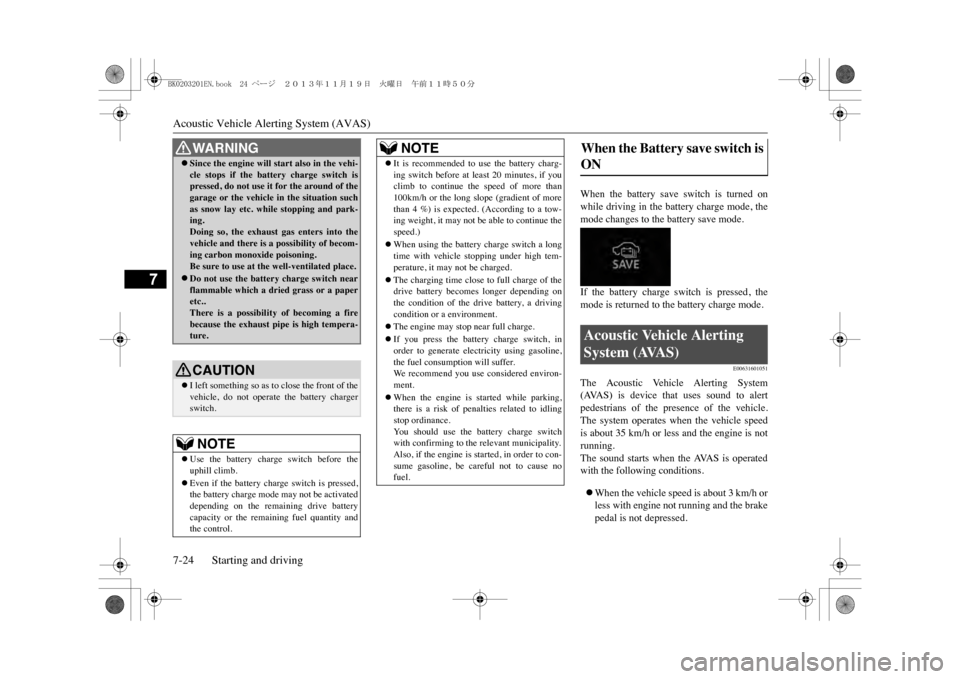
Acoustic Vehicle Alerting System (AVAS)7-24 Starting and driving
7
When the battery save switch is turned onwhile driving in the battery charge mode, themode changes to the battery save mode.If the battery charge switch is pressed, themode is returned to the battery charge mode.
E00631601051
The Acoustic Vehicle Alerting System(AVAS) is device that uses sound to alertpedestrians of the presence of the vehicle.The system operates when the vehicle speedis about 35 km/h or less and the engine is notrunning.The sound starts when the AVAS is operatedwith the following conditions.�zWhen the vehicle speed is about 3 km/h orless with engine not running and the brakepedal is not depressed.
�zSince the engine will start also in the vehi-cle stops if the batt
ery charge switch is
pressed, do not use it for the around of thegarage or the vehicle
in the situation such
as snow lay etc. while stopping and park-ing.Doing so, the exhaust gas enters into thevehicle and there is a possibility of becom-ing carbon monoxide poisoning.Be sure to use at the well-ventilated place.�zDo not use the battery charge switch nearflammable which a drie
d grass or a paper
etc..There is a possibility of becoming a firebecause the exhaust pipe is high tempera-ture.CAUTION�zI left something so as to close the front of thevehicle, do not operate the battery chargerswitch.NOTE
�zUse the battery charge switch before theuphill climb.�zEven if the battery charge switch is pressed,the battery charge mode may not be activateddepending on the remaining drive batterycapacity or the remaining fuel quantity andthe control.WA R N I N G
�zIt is recommended to use the battery charg-ing switch before at least 20 minutes, if youclimb to continue the speed of more than100km/h or the long slope (gradient of morethan 4 %) is expected. (According to a tow-ing weight, it may not be able to continue thespeed.)�zWhen using the battery charge switch a longtime with vehicle
stopping under high tem-
perature, it may not be charged.�zThe charging time close to full charge of thedrive battery becomes longer depending onthe condition of the drive battery, a drivingcondition or a environment.�zThe engine may stop near full charge.�zIf you press the battery charge switch, inorder to generate elec
tricity using gasoline,
the fuel consumption will suffer.We r e c o m m e n d y o u u s e c o n s i d e r e d e n v i r o n -ment.�zWhen the engine is started while parking,there is a risk of penalties related to idlingstop ordinance.Yo u s h o u l d u s e t h e b a t t e r y c h a r g e s w i t c hwith confirming to the relevant municipality.Also, if the engine is started, in order to con-sume gasoline, be careful not to cause nofuel.NOTE
When the Battery save switch is ON Acoustic Vehicle Alerting System (AVAS)
BK0203201EN.book 24 ページ 2013年11月19日 火曜日 午前11時50分
Page 313 of 388
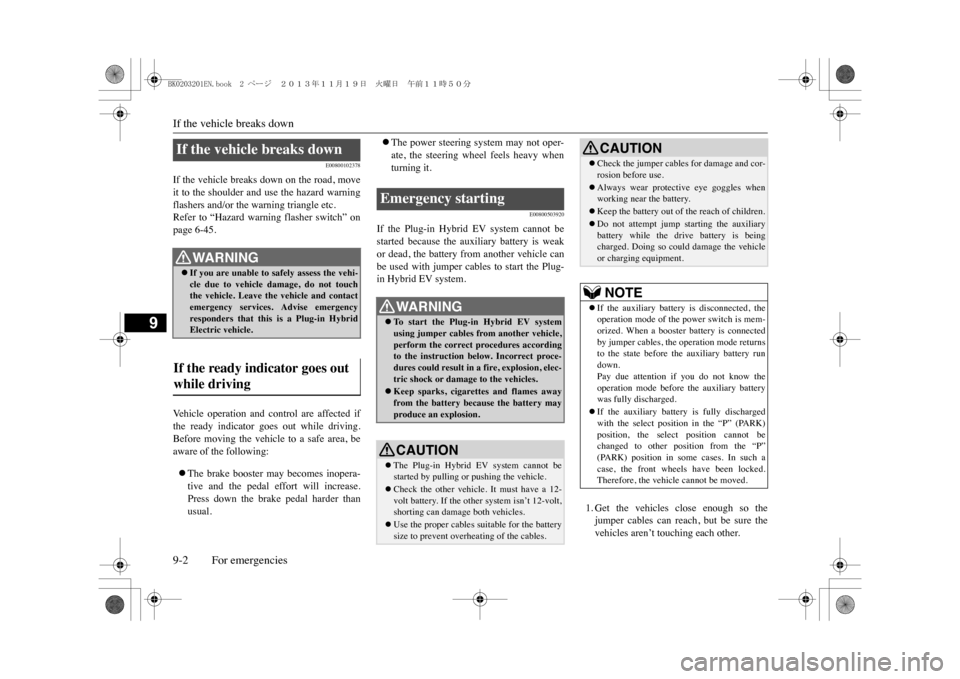
If the vehicle breaks down9-2 For emergencies
9
E00800102378
If the vehicle breaks down on the road, moveit to the shoulder and use the hazard warningflashers and/or the warning triangle etc.Refer to “Hazard warning flasher switch” onpage 6-45.Ve h i c l e o p e r a t i o n a n d c o n t r o l a r e a f f e c t e d i fthe ready indicator goes out while driving.Before moving the vehicle to a safe area, beaware of the following:�zThe brake booster may becomes inopera-tive and the pedal effort will increase.Press down the brake pedal harder thanusual.
�zThe power steering system may not oper-ate, the steering wheel feels heavy whenturning it.
E00800503920
If the Plug-in Hybrid EV system cannot bestarted because the auxiliary battery is weakor dead, the battery from another vehicle canbe used with jumper cables to start the Plug-in Hybrid EV system.
1. Get the vehicles close enough so thejumper cables can reach, but be sure thevehicles aren’t touching each other.
If the vehicle breaks down
WA R N I N G�zIf you are unable to safely assess the vehi-cle due to vehicle damage, do not touchthe vehicle. Leave the vehicle and contactemergency services. Advise emergencyresponders that this is a Plug-in HybridElectric vehicle.
If the ready indicator goes out while driving
Emergency starting
WA R N I N G�zTo s t a r t t h e P l u g - i n H y b r i d E V s y s t e musing jumper cables from another vehicle,perform the correct procedures accordingto the instruction below. Incorrect proce-dures could result in a fire, explosion, elec-tric shock or damage
to the vehicles.
�zKeep sparks, cigarettes and flames awayfrom the battery because the battery mayproduce an explosion.CAUTION�zThe Plug-in Hybrid EV system cannot bestarted by pulling or pushing the vehicle.�zCheck the other vehicle.
It must have a 12-
volt battery. If the other system isn’t 12-volt,shorting can damage
both vehicles.
�zUse the proper cables suitable for the batterysize to prevent overhea
ting of the cables.
�zCheck the jumper cables for damage and cor-rosion before use.�zAlways wear protect
ive eye goggles when
working near the battery.�zKeep the battery out of the reach of children.�zDo not attempt jump starting the auxiliarybattery while the drive battery is beingcharged. Doing so could damage the vehicleor charging equipment.NOTE
�zIf the auxiliary battery is disconnected, theoperation mode of the power switch is mem-orized. When a booster
battery is connected
by jumper cables, the operation mode returnsto the state before the auxiliary battery rundown.Pay due attention if you do not know theoperation mode before
the auxiliary battery
was fully discharged.�zIf the auxiliary battery is fully dischargedwith the select position in the “P” (PARK)position, the select position cannot bechanged to other position from the “P”(PARK) position in some cases. In such acase, the front wheels have been locked.Therefore, the vehicle cannot be moved.CAUTION
BK0203201EN.book 2 ページ 2013年11月19日 火曜日 午前11時50分
Page 339 of 388

Cleaning the exterior of your vehicle10-4 Vehicle care
10
Sea water contains salt, which generallyaccelerates corrosion of both ferrous and non-ferrous materials. Wind born spray from thesea can distribute salt for a distance of up to20 km from the shore line with prevailing on-shore winds, although the effect is generallyworse within 2 km of the shore. Salt spraycovers roads, and may be passed to your vehi-cle as dust, or as salt spray after rain. For thisreason it is important to wash all the vehicleincluding the underside (not forgetting theplug-in hybrid EV system bay and plug-inhybrid EV system bay components). See sec-tion entitled “Engine compartment” for rec-ommended cleaning practices.Ensure you request a MITSUBISHIMOTORS Authorised Service Point to con-duct the scheduled Preventative Maintenancecorrosion inspection if you live within 20 kmof the sea. Sea water spray in coastal condi-tions
WA R N I N G�zDo not wash the vehicle while charging thetraction battery.Doing so could cause a fire or an electricshock.
�zBefore washing the vehicle, make surethat the charging lid
and the inner lid are
completely closed.If the lid is open, the charging unit isexposed to water, resulting in a fire or anelectric shock.CAUTION�zWhen washing the under
side of your vehicle
or wheel, be careful not to injure your hands.�zIf your vehicle has rain sensor wipers, placethe wiper switch lever in the “OFF” positionto deactivate the rain sensor before washingthe vehicle. Otherwise, the wipers will oper-ate in the presence of water spray on thewindscreen and may get damaged as a result.�zRefrain from excessively using a car wash asits brushes may scratch the paint surface,causing it to lose its gloss. Scratches will beespecially visible on da
rker coloured vehi-
cles.�zNever spray or splash
water on the electrical
components in the engine compartment.Doing so could have an adverse effect on theplug-in hybrid EV system startability.Exercise caution also when washing theunderbody; be careful not to spray water intothe engine compartment.WA R N I N G
�zSome types of hot wa
ter washing equipment
apply high pressure and
heat to the vehicle.
They may cause heat distortion and damageto the vehicle resin parts and may result inflooding of the vehicle interior.Therefore;•Maintain a distance of approx. 70 cm ormore between the vehicle body and thewashing nozzle.•When washing around the door glass, holdthe nozzle at a distance of more than 70 cmand at right angles to the glass surface.
�zAfter washing the vehicle, drive the vehicleslowly while lightly depressing the brakepedal several times in order to dry out thebrakes.Leaving the brakes wet could result inreduced braking performance. Also, there isa possibility that they could freeze up orbecome inoperative due
to rust, rendering the
vehicle unable to move.�zUsing an automatic car wash, pay attentionto the following items, referring to the opera-tion manual or consulting a car wash opera-tor. If the following procedure is notfollowed, it could result in damage to yourvehicle.•The outside rear-view mirrors are retracted.•The antenna is removed.•The wiper arms are secured in place withtape.CAUTION
BK0203201EN.book 4 ページ 2013年11月19日 火曜日 午前11時50分
Page 370 of 388
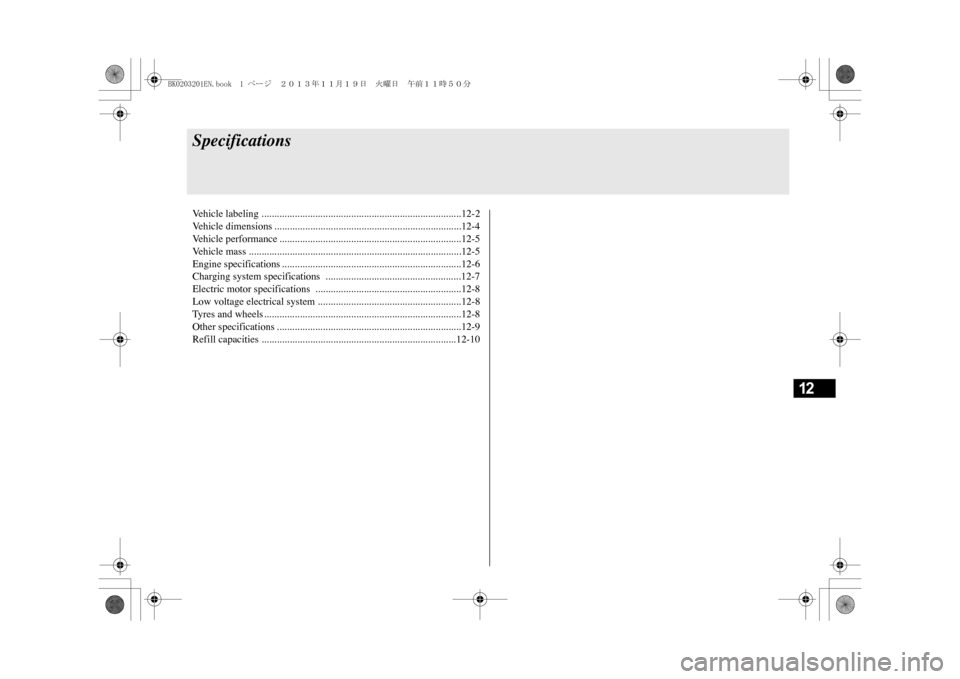
12
SpecificationsVe h i c l e l a b e l i n g . . . . . . . . . . . . . . . . . . . . . . . . . . . . . . . . . . . . . . . . . . . . . . . . . . . . . . . . . . . . . . . . . . . . . . . . . . . . . . 1 2 - 2Ve h i c l e d i m e n s i o n s . . . . . . . . . . . . . . . . . . . . . . . . . . . . . . . . . . . . . . . . . . . . . . . . . . . . . . . . . . . . . . . . . . . . . . . . . 1 2 - 4Ve h i c l e p e r f o r m a n c e . . . . . . . . . . . . . . . . . . . . . . . . . . . . . . . . . . . . . . . . . . . . . . . . . . . . . . . . . . . . . . . . . . . . . . . 1 2 - 5Ve h i c l e m a s s . . . . . . . . . . . . . . . . . . . . . . . . . . . . . . . . . . . . . . . . . . . . . . . . . . . . . . . . . . . . . . . . . . . . . . . . . . . . . . . . . . . 1 2 - 5Engine specifications ......................................................................12-6Charging system specifications .....................................................12-7Electric motor specifications .........................................................12-8Low voltage electrical system ........................................................12-8Ty r e s a n d w h e e l s . . . . . . . . . . . . . . . . . . . . . . . . . . . . . . . . . . . . . . . . . . . . . . . . . . . . . . . . . . . . . . . . . . . . . . . . . . . . . 1 2 - 8Other specifications ........................................................................12-9Refill capacities ............................................................................12-10
BK0203201EN.book 1 ページ 2013年11月19日 火曜日 午前11時50分
Page 376 of 388
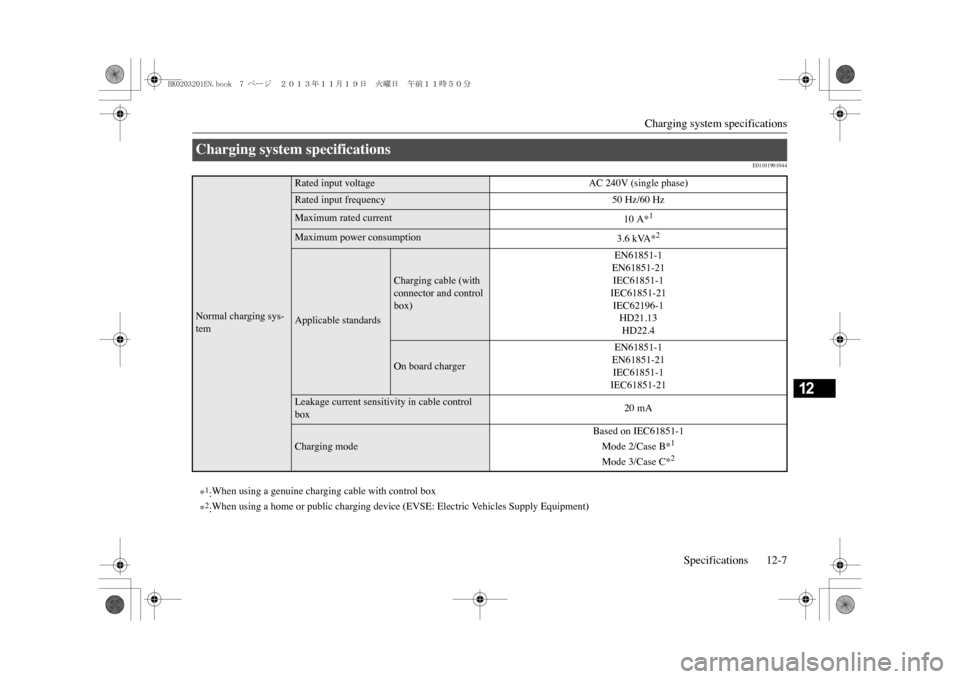
Charging system specifications
Specifications 12-7
12
E01101901044
Charging system specifications Normal charging sys-tem
Rated input voltage
AC 240V (single phase)
Rated input frequency
50 Hz/60 Hz
Maximum rated current
10 A*
1
Maximum power consumption
3.6 kVA*
2
Applicable standards
Charging cable (with connector and control box)
EN61851-1EN61851-21IEC61851-1IEC61851-21IEC62196-1HD21.13HD22.4
On board charger
EN61851-1EN61851-21IEC61851-1IEC61851-21
Leakage current sensitivity in cable control box
20 mA
Charging mode
Based on IEC61851-1Mode 2/Case B*
1
Mode 3/Case C*
2
*1:When using a genuine charging cable with control box
*2:When using a home or public charging device (EVSE: Electric Vehicles Supply Equipment)
BK0203201EN.book 7 ページ 2013年11月19日 火曜日 午前11時50分
Page 377 of 388
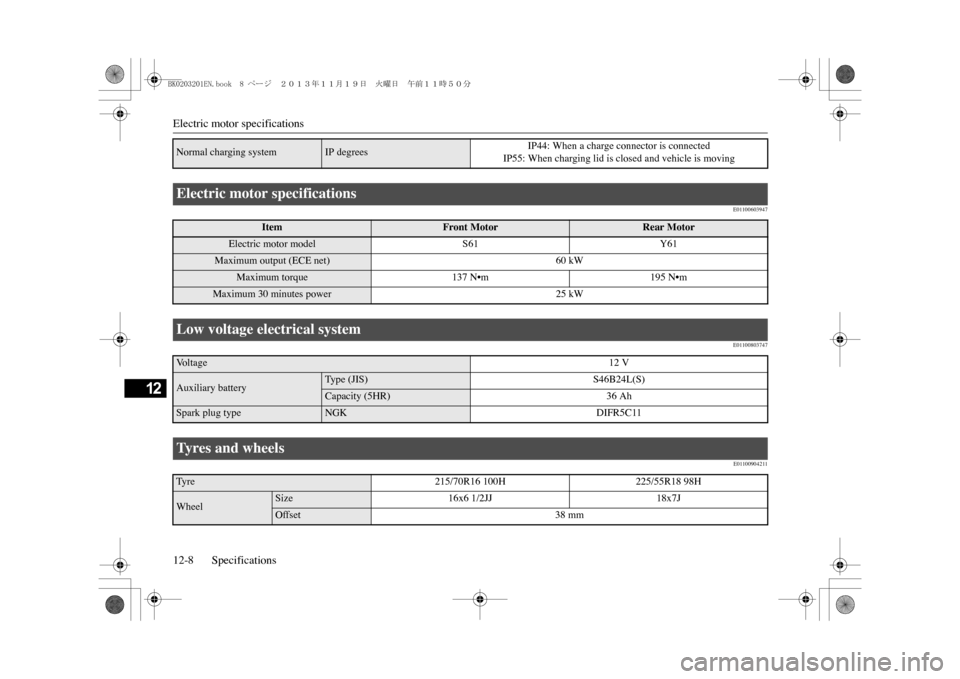
Electric motor specifications12-8 Specifications
12
E01100603947E01100803747E01100904211
Normal charging system
IP degrees
IP44: When a charge connector is connected
IP55: When charging lid is closed and vehicle is moving
Electric motor specifications
Item
Front Motor
Rear Motor
Electric motor model
S61
Y61
Maximum output (ECE net)
60 kW
Maximum torque
137 N•m
195 N•m
Maximum 30 minutes power
25 kW
Low voltage electrical system Vo l t a g e
12 V
Auxiliary battery
Ty p e ( J I S )
S46B24L(S)
Capacity (5HR)
36 Ah
Spark plug type
NGK
DIFR5C11
Ty r e s a n d w h e e l s Ty r e
215/70R16 100H
225/55R18 98H
Wheel
Size
16x6 1/2JJ
18x7J
Offset
38 mm
BK0203201EN.book 8 ページ 2013年11月19日 火曜日 午前11時50分
Page 382 of 388
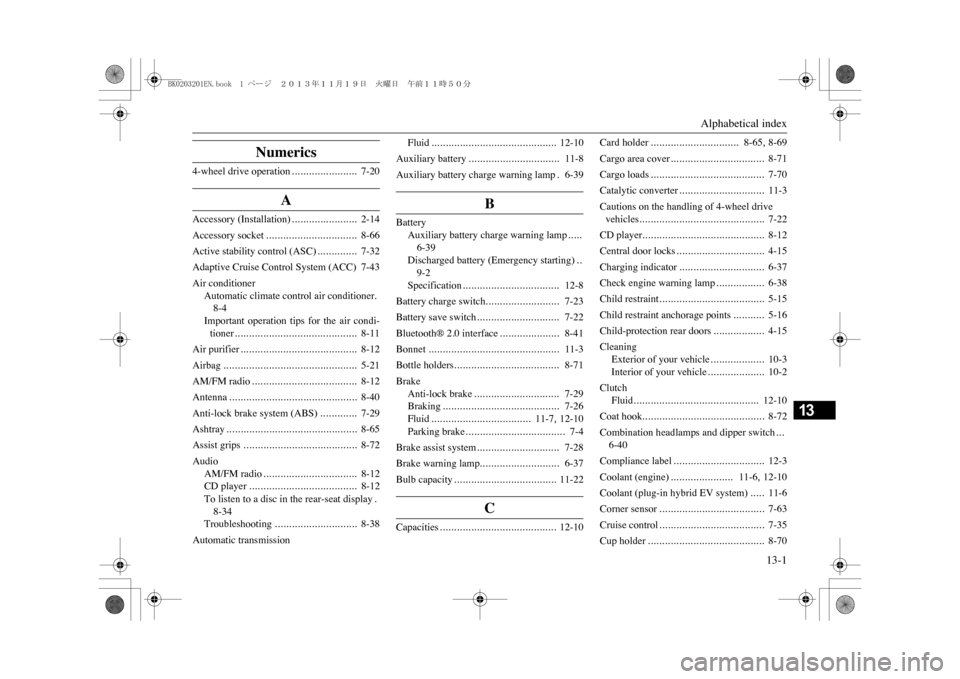
Alphabetical index
13-1
13
Numerics
4-wheel drive operation
.......................
7-20
A
Accessory (Installation)
.......................
2-14
Accessory socket
................................
8-66
Active stability control (ASC)
..............
7-32
Adaptive Cruise Control System (ACC) 7-43Air conditioner
Automatic climate control air conditioner
.
8-4Important operation tips for the air condi-tioner
...........................................
8-11
Air purifier
.........................................
8-12
Airbag
...............................................
5-21
AM/FM radio
.....................................
8-12
Antenna
.............................................
8-40
Anti-lock brake system (ABS)
.............
7-29
Ashtray
..............................................
8-65
Assist grips
........................................
8-72
Audio
AM/FM radio
.................................
8-12
CD player
......................................
8-12
To listen to a disc in the rear-seat display
.
8-34Troubleshooting
.............................
8-38
Automatic transmission
Fluid
............................................
12-10
Auxiliary battery
................................
11-8
Auxiliary battery charge warning lamp
.6-39
B
Battery
Auxiliary battery charge warning lamp
.....
6-39Discharged battery (Emergency starting)
..
9-2Specification
..................................
12-8
Battery charge switch
..........................
7-23
Battery save switch
.............................
7-22
Bluetooth® 2.0 interface
.....................
8-41
Bonnet
..............................................
11-3
Bottle holders
.....................................
8-71
Brake
Anti-lock brake
..............................
7-29
Braking
.........................................
7-26
Fluid
...................................
11-7
, 12-10
Parking brake
...................................
7-4
Brake assist system
.............................
7-28
Brake warning lamp
............................
6-37
Bulb capacity
....................................
11-22
C
Capacities
.........................................
12-10
Card holder
...............................
8-65
, 8-69
Cargo area cover
.................................
8-71
Cargo loads
........................................
7-70
Catalytic converter
..............................
11-3
Cautions on the handling of 4-wheel drive vehicles
............................................
7-22
CD player
...........................................
8-12
Central door locks
...............................
4-15
Charging indicator
..............................
6-37
Check engine warning lamp
.................
6-38
Child restraint
.....................................
5-15
Child restraint anchorage points
...........
5-16
Child-protection rear doors
..................
4-15
Cleaning
Exterior of your vehicle
...................
10-3
Interior of your vehicle
....................
10-2
Clutch
Fluid
............................................
12-10
Coat hook
...........................................
8-72
Combination headlamps and dipper switch
...
6-40Compliance label
................................
12-3
Coolant (engine)
......................
11-6
, 12-10
Coolant (plug-in hybrid EV system)
.....
11-6
Corner sensor
.....................................
7-63
Cruise control
.....................................
7-35
Cup holder
.........................................
8-70
BK0203201EN.book 1 ページ 2013年11月19日 火曜日 午前11時50分